Exploring Manta Ray Sizes and Growth Factors
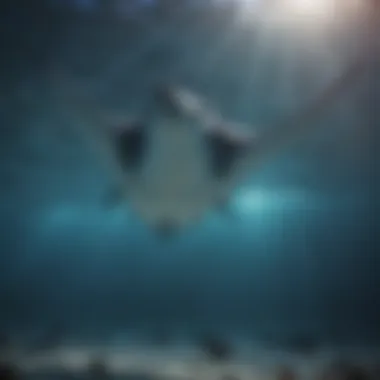
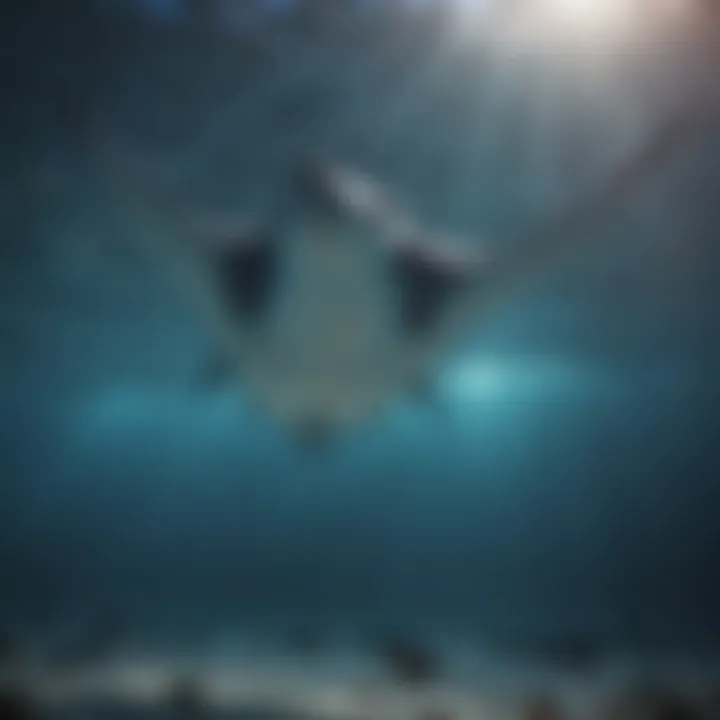
Intro
Manta rays are not just ordinary sea creatures; they are giants roaming the oceans, captivating scientists and marine enthusiasts alike. Their sheer size and grace in the water make them a fascinating subject of study. But, when one begins to peel back the layers of information, a rich tapestry of size variations and anatomical intricacies starts to emerge.
These remarkable creatures belong to two species: the Manta birostris and the Manta alfredi. Understanding their size is more than just knowing how long they can stretch across the ocean. It interweaves with aspects of their biology, ecology, and conservation efforts needed to protect these gentle giants and their habitats.
This section will outline the key concepts surrounding manta ray sizes, delve into why these variations matter, and discuss how threats to their growth and populations impact the marine environment. Throughout our exploration, we aim to present a detailed understanding that not only informs but also inspires action toward conservation endeavors.
Overview of Research Topic
Brief Background and Context
Manta rays have been the subject of various studies over the years. Their size can vary notably depending on the species and environmental conditions. The Manta birostris, commonly known as the giant manta ray, can reach wingspans of up to 29 feet, while the smaller Manta alfredi can grow to around 11 feet. Such significant size differences prompt inquiries into the evolutionary and ecological factors that contribute to these variations.
Additionally, habitat plays a crucial role. Manta rays inhabit tropical and subtropical waters, often found near coral reefs and other coastal ecosystems. These environments not only influence their growth patterns but also their feeding habits and mating rituals.
Importance in Current Scientific Landscape
In current environmental research, the significance of studying manta ray sizes cannot be overstated. With climate change affecting marine habitats and influencing food availability, understanding these size dynamics is paramount. Furthermore, monitoring their growth can provide insights into the health of marine ecosystems and the impacts of human activity.
"Understanding manta rays' sizes is key to decoding the overall health of the marine environment. Their presence indicates a thriving ecosystem, while their decline can signify underlying issues."
Methodology
Research Design and Approach
An essential part of researching manta ray sizes involves a multi-faceted approach that includes observational studies, field research, and data analysis. Scientists often employ tagging and tracking techniques to measure their growth over time and observe their behaviors in differing environmental contexts.
Data Collection Techniques
Data collection is typically achieved through:
- Field Surveys: Direct observations in key habitats such as the Great Barrier Reef or the Maldives.
- Technology: Utilization of underwater drones and camera systems to gather visual data on populations and sizes.
- Collaborative Efforts: Engagement with local communities and organizations helps collect anecdotal evidence on their sightings and behaviors.
This in-depth approach not only enriches the understanding of their physical dimensions but also integrates broader ecological perspectives that are vital for the conservation of these magnificent creatures.
Prolusion to Manta Rays
Manta rays, often dubbed the gentle giants of the ocean, carry with them an allure that goes beyond their majestic size. Exploring this topic opens up a window not merely into the physical dimensions of these creatures, but also into their ecological role and the factors that dictate their growth. Understanding manta rays is significant for marine biology, conservation efforts, and our broader comprehension of oceanic ecosystems.
By examining these magnificent beings, we learn about evolution, their unique adaptations, and how they fit within the marine food web. The insights gained here can pave the way for better protection measures and a more informed public discourse about their conservation.
Overview of Manta Rays
Manta rays belong to the family Mobulidae, known for their distinct, flattened bodies and wing-like pectoral fins which enable them to glide gracefully through the water. The two predominant species are the giant oceanic manta ray (Manta birostris) and the reef manta ray (Manta alfredi). Both species exhibit a remarkable wingspan, capable of reaching up to seven meters in length for Manta birostris, while their counterparts, the reef manta ray, can achieve around five meters.
These creatures predominantly dwell in tropical and subtropical waters. Their presence is often associated with coral reefs and areas abundant in plankton, as these are their primary food sources. Drifting serenely in the ocean currents, manta rays filter-feed on small marine organisms, showcasing a tranquil yet vital aspect of the underwater ecosystem.
Importance of Size in Marine Biology
Size serves as a crucial factor not just in terms of biology, but also in conservation. The sheer size of manta rays influences their feeding habits, reproductive strategies, and vulnerability to environmental changes.
- Feeding Dynamics: Larger manta rays can consume greater volumes of plankton and small fish than smaller fish, affecting the population dynamics of their prey. Hence, they play a pivotal role in controlling the balance within their ecosystem.
- Reproductive Rates: Size can also impact maturation. Larger females may possess a reproductive advantage, providing them with the capacity to produce more offspring or larger volumes of gametes, thus influencing the growth of their populations.
- Threat Vulnerability: Being larger is not always beneficial. Bigger manta rays may find themselves more exposed to threats from human activities like fishing and habitat degradation, which can affect their survival rates and consequently, the health of their populations.
In summary, size not only defines the physical characteristics of manta rays but also encapsulates their ecological significance and the conservation challenges they face. The exploration of their dimensions opens a door to understand the intricate balance of marine life and the pressing need for their protection.
Species of Manta Rays


The world of manta rays is home to various species, each displaying unique characteristics that contribute to their ecological significance. Understanding these species isn’t just an academic pursuit. It's essential for marine conservation efforts and the continued survival of these gentle giants. By exploring the distinctions and nuances among different manta ray species, researchers can more effectively address conservation needs and understand their roles in marine ecosystems.
Manta Birostris
Manta Birostris, commonly known as the giant oceanic manta ray, is the largest of all species. This species can reach wingspans of up to 29 feet. Such dimensions are not merely impressive; they play vital roles in their behavior and interactions within the marine environment. The size aids in efficient swimming, allowing them to glide through water with ease, and helps them capture prey, mainly small fish and plankton.
The coloration, typically a dark blue or gray, with white markings on their underbelly, serves a dual purpose. Firstly, it acts as camouflage from predators while swimming above the seabed. Secondly, it plays into their social interactions, where patterns may be used for communication among their species. Notably, Manta Birostris has been observed engaging in complex behavioral displays, further illustrating the role of physical size in their social structure.
In terms of habitat, these rays prefer deep, open waters, often found in oceanic regions. Their migratory patterns tend to be more extensive compared to other species, which could be a response to food availability or environmental conditions. Thus, conserving their habitats is crucial for their survival. Unfortunately, Manta Birostris is facing pressures from fishing, habitat destruction, and climate change, making it more important than ever to appreciate its ecological role and ensure its protection.
Manta Alfredi
On the other side of the spectrum is Manta Alfredi, the reef manta ray. While it may not reach the enormous sizes of its oceanic counterpart, it boasts a respectable wingspan of about 23 feet. These rays tend to flourish in shallower waters of coral reefs and exhibit a more localized lifestyle compared to Manta Birostris. This translates to less extensive migratory patterns, resulting in a connection to specific reef habitats and ecosystems.
Manta Alfredi's unique adaptations to their environment allow for a different range of social interactions and feeding strategies. They often engage in a behavior known as "station keeping," where they hover in areas of strong current to feed on plankton-rich water. Their smaller size compared to Manta Birostris also affects their feeding method, as they are generally more adept at navigating closer to reefs and among corals.
The coloration of Manta Alfredi is notably distinct, often displaying a pattern of white spots or bands on their dorsal side. This not only adds to their individual identity but also helps in recognizing them within the reef systems. Conservation efforts aimed at protecting their habitats are crucial, as reef destruction and water pollution pose significant risks to their populations.
Overall, the species distinctions among manta rays underline the importance of understanding their various adaptations and habitats. By studying these differences, researchers can inform conservation strategies that are tailored to the specific needs of each species. This ultimately contributes to the resilience of marine ecosystems as a whole, ensuring that these magnificent creatures continue to thrive in our oceans.
Size Characteristics of Manta Rays
The size characteristics of manta rays are not just fascinating trivia; they hold significant importance in understanding their biology, behavior, and ecological roles. Grasping the dimensions of these magnificent creatures can illuminate various aspects of marine life. For instance, the size can affect their movement patterns, predatory and reproductive strategies, as well as how they interact with their environment. Knowledge about their size is crucial for conservation efforts as well. Recognizing that these animals can reach impressive wingspans allows for better assessments of their habitats and the spaces needed for their preservation.
Wingspan Measurements
Manta rays are renowned for their striking wingspan, which can vary significantly between species. The giant oceanic manta ray, Manta birostris, can have a wingspan that stretches up to an incredible 29 feet (about 8.8 meters). This remarkable measurement makes it one of the largest species in the ocean. On the other hand, the reef manta ray, Manta alfredi, usually has a more modest wingspan, averaging around 16 feet (about 4.9 meters).
This difference in wingspan can be attributed to several factors, including
- Species: Unique species adaptations impact size. Manta birostris is suited for open ocean migrations, needing more span for efficient travel.
- Age and Growth Stages: Like many creatures, younger manta rays will have smaller wingspans, progressively growing larger during maturation.
- Environmental Conditions: Accessibility to proper food sources and habitat can also play a role in size development. For instance, in nutrient-rich waters, manta rays might grow larger due to adequate nutrition.
Understanding these measurements not only piques interest but assists in tracking population health and environmental changes.
Body Length Variations
The body length of manta rays is another critical measurement that correlates with their wingspan. Generally, the body can range between 8 to 26 feet (approximately 2.4 to 8 meters) in length. The hookups between body length and habitat preferences are especially relevant; manta rays prefer various environments, from shallow coastal waters to the deep sea.
Factors that influence these variations include:
- Habitat Location: Manta rays residing in different habitats, like reefs compared to open ocean areas, may display longer or shorter lengths based on space availability and prey types.
- Genetic Disposition: Just as in humans, certain genetic traits may influence growth rates.
- Sexual Dimorphism: Males and females may grow differently, with females often reaching larger sizes than males, which could be linked to reproductive strategies.
Weight Range
The weight of manta rays also varies widely, which adds another layer to their size characteristics. For the Manta birostris, adult individuals can weigh between 1,200 to 2,200 pounds (around 540 to 1,000 kilograms). Conversely, the reef manta ray is generally lighter, averaging around 800 to 1,300 pounds (approximately 360 to 590 kilograms).
This weight disparity can impact:
- Predation and Vulnerability: Larger manta rays may have fewer natural predators, while smaller ones could be susceptible to various threats in the marine food web.
- Ecological Role: Their weight, coupled with their feeding habits, can influence the ecosystem's health. Bigger animals filter more water during feeding, enhancing nutrient cycling.
- Conservation Status: Knowing the average weights assists conservationists. If populations decline at certain weight thresholds, it may indicate the ecosystem's health is at risk.
To put it plainly, understanding the size characteristics of manta rays provides insight into their roles in the marine ecosystem and the ongoing efforts needed to protect them. Their impressive wingspans, variable body lengths, and diverse weight ranges make them quintessential figures of the ocean, worthy of admiration and monumental for ecological health.
Factors Influencing the Size of Manta Rays
Genetic Factors
Genetics forms the foundation of any living organism's physical attributes, and manta rays are no exception. These genetic traits dictate not only size but also aspects such as pigmentation, anatomy, and growth rates.
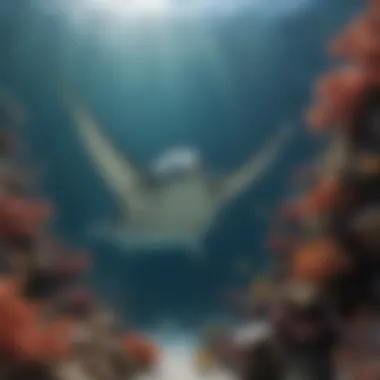
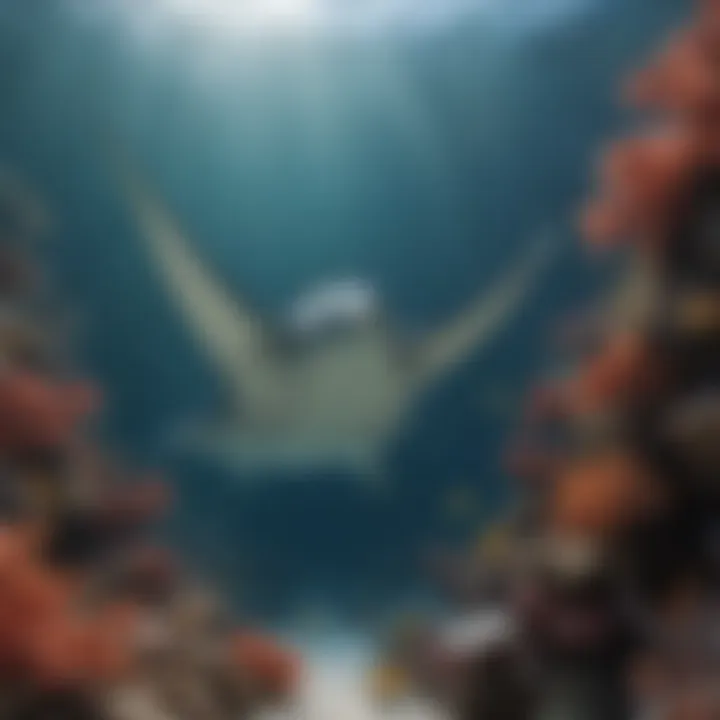
Different manta ray species, like the Manta Birostris and Manta Alfredi, exhibit unique genetic characteristics that contribute to size differences. For instance, studies suggest that Manta Birostris, which is generally larger, possesses genes that facilitate more robust growth compared to its smaller counterpart, Manta Alfredi. The genetic diversity present within populations also brings about variations in size.
Significantly, environmental stresses can trigger certain genetic expressions, affecting how these creatures grow in various conditions. Moreover, research is ongoing in understanding how selective pressures may naturally favor larger individuals in some populations, particularly in predator-rich environments.
Environmental Influences
The environment where a manta ray lives drastically influences its growth and size. Key aspects include water temperature, salinity, and availability of habitats. Warmer waters often promote faster metabolic rates, which can accelerate growth. Conversely, if a manta ray resides in colder waters, growth may be stunted, leading to smaller sizes.
Additionally, the presence of human activities, such as fishing or pollution, can compromise habitats critical for feeding and breeding, ultimately affecting size. For example, areas with abundant plankton, which manta rays feed on, are vital for their growth. Overfishing of these foods can lead to a lack of nutrition, hindering size development.
Ecosystem balance plays a big role, too. In an overly competitive environment, smaller or weaker individuals may not survive to maturity, thus skewing the size distribution.
Diet and Nutrition
What a manta ray eats, or rather, how much it can eat in relation to its environment, directly impacts its size. Manta rays are filter feeders, primarily consuming plankton and small fish. The abundance or scarcity of these food sources can dictate their growth patterns. The size of available prey—often tied to environmental conditions—also impacts how effectively they can feed.
A well-nourished manta ray, thriving in environments rich in plankton, can reach impressive sizes due to optimal growth conditions. Studies have shown that those rays that have access to diverse and plentiful food displays significant size advantages over those that don’t. Furthermore, the energy derived from a balanced diet supports not just growth but reproduction as well, increasing the chances of larger offspring.
In essence, genetics, environment, and diet interplay continuously, shaping the sizes of manta rays in complex ways.
"Manta rays serve as a fascinating example of how various factors converge to influence the growth of a species, embodying the intricate balance of marine ecosystems."
Analyzing these factors allows researchers, conservationists, and the general public to appreciate the significance of environment and nutrition for the growth of these remarkable marine creatures.
Habitat and Behavior
Understanding the habitat and behavior of manta rays is crucial as it directly influences their size and overall health. Manta rays are not just fascinating creatures; they're also indicators of ocean health. Their habitats reflect the quality of marine environments, which can shift due to external factors. Hence, examining where they dwell helps us gauge prevailing ecological conditions.
Common Habitats
Manta rays can be seen in various marine ecosystems, often in places that offer abundant food and specific environmental conditions. They prefer tropical and subtropical waters, with some species venturing into cooler regions. These magnificent animals are often found in:
- Coastal waters: Near coral reefs and other rising frames, where their prey, like plankton and small fish, thrives.
- Open ocean: Some manta rays can be spotted far from shore in the pelagic zone, where they glide effortlessly, searching for food.
- Cleaning stations: Certain locations act as sanctuaries for manta rays, where small cleaner fish maintain their well-being by removing parasites. These zones are vital for their health, and they often return to them regularly.
Their preference for these habitats is not random. The presence of light, temperature, and water clarity greatly affects where they can thrive. Furthermore, the available food sources determine whether they can maintain their remarkable size and vigor.
Migration Patterns
Manta rays are migratory by nature, often following the rhythms of the ocean. Their movements are not based on whim; instead, they align with the availability of food sources and breeding grounds. They tend to engage in seasonal migrations, which can be influenced by ocean currents and water temperature.
Notable migration patterns of mantas include:
- Feeding migrations: For instance, when upwelling currents bring nutrient-rich waters, mantas may travel hundreds of kilometers to areas where food is plentiful.
- Reproductive migrations: Manta rays often travel to specific spots during breeding seasons, creating a fascinating seasonal dance in the ocean. Knowing these patterns helps researchers protect breeding sites critical to maintaining manta populations.
- Following the currents: Ocean currents play a huge role in their long-distance travels. Mantas seem to know how to utilize these currents to conserve energy while searching for food in vast ocean territories.
Recognizing these migration patterns is vital to understanding how environmental changes could affect their size and population dynamics. Since manta rays can traverse large distances to find suitable habitats, this adaptability often highlights their resilience in a shifting ecosystem.
"Manta rays are not just beautiful; they are a high-achieving marvel of adaptability in marine life. Their journeys speak volumes about the interconnectedness of aquatic habitats."
In summary, the habitat and behavior of manta rays are intertwined with their size and growth. Each space they inhabit contributes to their well-being, supporting their hefty bodies and graceful movements in the waters they call home.
Conservation and Threats
The conservation of manta rays is not just a matter of environmental ethics; it plays a significant role in maintaining the biodiversity of marine ecosystems. Understanding the threats these magnificent creatures face is crucial for developing effective conservation strategies. Their populations have decreased dramatically, and their future depends on coordinated global efforts. This section sheds light on the specific challenges to their survival as well as ongoing conservation measures that aim to protect them. It’s about acknowledging the importance of preserving these unique animals for future generations, ensuring we don’t lose a key player in the ocean's ecosystem.
Human Impact on Manta Ray Populations
Human activities pose a substantial threat to manta ray populations worldwide. Here are some of the key factors:
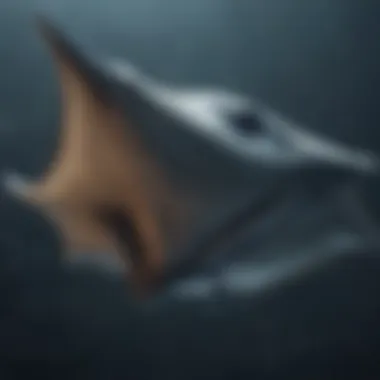
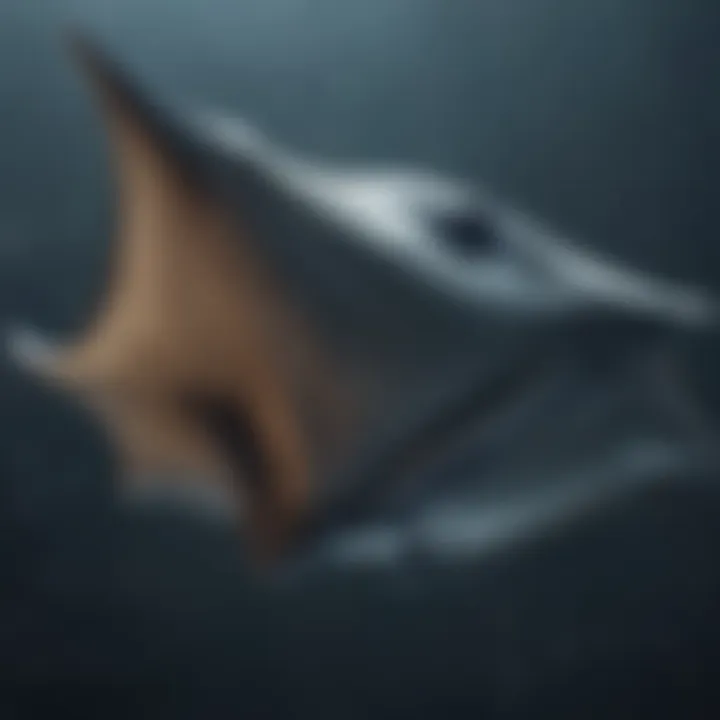
- Overfishing: Manta rays are often caught accidentally in fishing nets or targeted for their gill rakers, which fetch high prices in traditional medicine markets.
- Habitat Destruction: Coastal development and marine pollution significantly degrade their habitats. Clean water environments are crucial for the growth and reproduction of manta rays. When these areas are compromised, it affects their survival.
- Climate Change: As ocean temperatures rise, the distribution of prey species for manta rays, mainly plankton, shifts. This can severely impact their ability to feed and reproduce.
"Manta rays are not just beautiful; they symbolize the health of our oceans. Their decline is a stark reminder that marine life is under constant threat."
Awareness of these issues is growing, but we need a concerted global initiative to address them effectively. Education and advocacy play essential roles in the fight for manta conservation.
Conservation Efforts
Numerous organizations and research institutions are dedicated to the conservation of manta rays. Here are some notable approaches:
- Protected Areas: Some regions have established marine protected areas (MPAs) where manta rays are safeguarded from harmful activities like fishing and habitat destruction. These areas allow natural populations to thrive and recover, showing promising benefits for the ecosystem.
- Legislation: International laws, such as the Convention on Migratory Species, play a role in protecting manta rays. Countries are encouraged to implement regulations that prevent overexploitation and ensure sustainable fishing practices.
- Research and Monitoring: Organizations are investing in scientific studies to better understand manta ray behaviors, migration patterns, and population dynamics. This research is vital for making informed decisions on conservation measures.
- Community Involvement: Engaging local communities in conservation efforts has proven successful in various regions. When fishermen understand the ecological role of manta rays, they are more likely to support measures that protect them.
Conservation efforts are intertwined with the broader goal of preserving marine biodiversity. Every small step taken today can make a significant impact for future generations, ensuring that these incredible creatures continue to grace our oceans.
Research and Study
Researchers employ diverse methodologies for measuring manta rays, and precise measurements are key to successful observations. Accurate data is essential when determining their growth patterns and behaviors, ultimately impacting conservation strategies.
As scientists delve deeper into the nuances of manta ray size, the benefits abound. Understanding size can also provide clues to their health and reproductive success, adding another layer to their ecological puzzle.
"The study of manta rays is not merely about their size; it's about understanding an intricate web of interactions that sustain ocean health."
Methods of Measurement
Various techniques are employed when looking to measure the size of manta rays. First up, photogrammetry is an effective method that uses specialized photographs to calculate dimensions. Researchers typically take high-resolution images of manta rays while they swim, allowing them to analyze the data later.
Another method is direct measurement, which, although labor-intensive, gives the most accurate figures. This method often relies on capturing the rays temporarily, during which their wingspan and body length can be meticulously recorded.
Here are some of the common methods utilized:
- Photogrammetry: Non-invasive, lets rays swim freely.
- Direct Measurement: Ensures accuracy, but requires careful handling.
- Acoustic Monitoring: Uses sound waves to estimate distance and can provide insights into their movements.
Recent Findings
Recent research has unveiled some intriguing aspects concerning the growth patterns of manta rays. For example, a study published in Marine Biology highlighted that certain populations of Manta birostris grow faster in nutrient-rich waters. This finding implies that food availability plays a significant role in their size, emphasizing the link between habitat and growth.
Moreover, genetic studies have shown variations in size amongst individual manta rays, suggesting a deeper level of adaptation to their respective environments. Notably, research by Smith et al. revealed that larger manta rays generally have higher reproductive success, which can create tension between conservation efforts and tourism.
In summary, these findings underline the importance of continued research as they can influence not only local conservation strategies but also inform global efforts to understand the dynamics of marine life.
Finale
The conclusion of this article serves several crucial purposes. First and foremost, it synthesizes the key findings regarding the size of manta rays, which are central to our understanding of these remarkable creatures. Size is not just a number when it comes to manta rays; it holds implications for their behavior, ecological roles, and even conservation strategies. A clear grasp of the size variations among different species, for instance, can influence how we approach habitat protection and management efforts.
Moreover, as we step back and look at the bigger picture, one must consider how the size of these gentle giants may change in response to various environmental stimuli. Changes in ocean conditions or human activities can significantly impact their growth and distribution patterns. Equipped with this knowledge, researchers and conservationists can better advocate for the protection of their habitats and create strategies that are scientifically informed.
"Understanding the dimensions of manta rays is key to ensuring their survival in an ever-changing marine environment."
Summary of Key Points
In summarizing what we've explored throughout this article:
- Manta rays exhibit significant size variability among species, with Manta birostris being notably larger than Manta alfredi.
- The measurement of size encompasses various factors, including wingspan, body length, and weight, each providing insights into the overall health and habits of these rays.
- Understanding genetics, environmental influences, and diet are essential in grasping what contributes to their growth and sustainability.
- Conservation efforts are increasingly vital, as human impacts threaten their populations and natural habitats.
By contextualizing all these elements, it becomes evident that size is a reflection of more than mere physicality; it is a gateway to deeper ecological understanding.
Future Directions in Manta Ray Research
Looking ahead, the future of manta ray research is filled with potential. Several key directions warrant attention.
- Advancements in Measurement Techniques: There's a growing need for more refined methods in assessing the sizes and populations of manta rays. Innovations such as drone technology and underwater imaging systems could enhance our ability to monitor these species in real-time.
- Longitudinal Studies: Investigating how size and population dynamics change over time can provide insights into the effects of climate change and human interference on manta ray populations.
- Health and Nutrition Research: Taking a closer look at how size influences the dietary needs of various species may illuminate new angles in conservation practices. Collaboration between marine biologists and nutrition experts could yield fascinating findings.
- Global Conservation Initiatives: As awareness of the ecological significance of manta rays grows, there is an opportunity for global initiatives that advocate for sustainable practices across countries, fostering cooperative efforts in conservation.
While these paths may present challenges, the potential benefits to both manta ray populations and marine ecosystems as a whole make the pursuit worthwhile.



